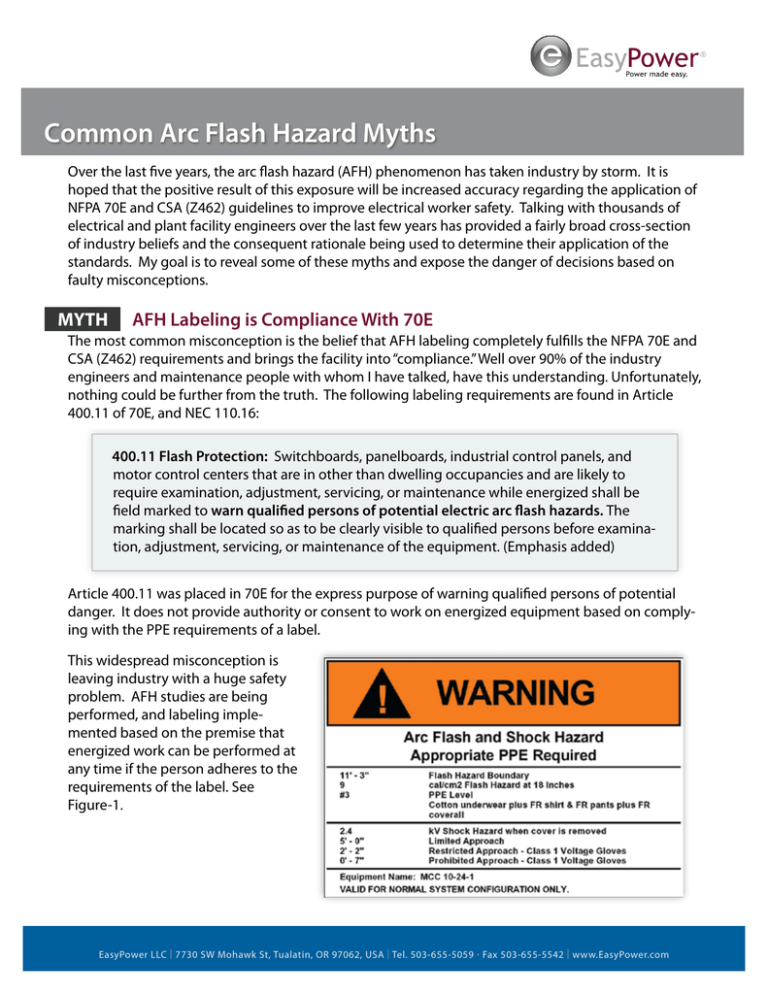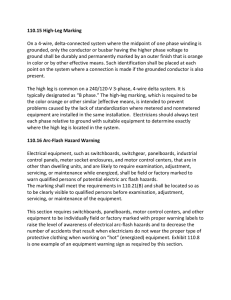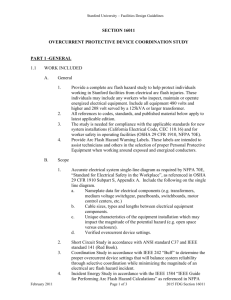Common Arc Flash Hazard Myths 2015
advertisement

® Common Arc Flash Hazard Myths Over the last five years, the arc flash hazard (AFH) phenomenon has taken industry by storm. It is hoped that the positive result of this exposure will be increased accuracy regarding the application of NFPA 70E and CSA (Z462) guidelines to improve electrical worker safety. Talking with thousands of electrical and plant facility engineers over the last few years has provided a fairly broad cross-section of industry beliefs and the consequent rationale being used to determine their application of the standards. My goal is to reveal some of these myths and expose the danger of decisions based on faulty misconceptions. MYTH AFH Labeling is Compliance With 70E The most common misconception is the belief that AFH labeling completely fulfills the NFPA 70E and CSA (Z462) requirements and brings the facility into “compliance.” Well over 90% of the industry engineers and maintenance people with whom I have talked, have this understanding. Unfortunately, nothing could be further from the truth. The following labeling requirements are found in Article 400.11 of 70E, and NEC 110.16: 400.11 Flash Protection: Switchboards, panelboards, industrial control panels, and motor control centers that are in other than dwelling occupancies and are likely to require examination, adjustment, servicing, or maintenance while energized shall be field marked to warn qualified persons of potential electric arc flash hazards. The marking shall be located so as to be clearly visible to qualified persons before examination, adjustment, servicing, or maintenance of the equipment. (Emphasis added) Article 400.11 was placed in 70E for the express purpose of warning qualified persons of potential danger. It does not provide authority or consent to work on energized equipment based on complying with the PPE requirements of a label. This widespread misconception is leaving industry with a huge safety problem. AFH studies are being performed, and labeling implemented based on the premise that energized work can be performed at any time if the person adheres to the requirements of the label. See Figure-1. EasyPower LLC | 7730 SW Mohawk St, Tualatin, OR 97062, USA | Tel. 503-655-5059 · Fax 503-655-5542 | www.EasyPower.com TRUTH In order to work on any energized equipment above 50 volts, an energized work permit is required. 130.1 Justification for Work: Live parts to which an employee might be exposed shall be put in an electrically safe work condition before an employee works on or near them, unless the employer can demonstrate that deenergizing introduces additional or increased hazards or is infeasible due to equipment design or operational limitations. The work permit is one of the cornerstones of NFPA 70E and cannot be bypassed by a labeling system. The employer and its management team is directly responsible for implementing not only a work permit process, but all the other aspects of safety such as job briefings, LOTO, safety training, and detailed work practices. MYTH More Labeling Equals More Safety Coinciding with the misconception that labeling allows energized work, is the idea that more labels equal increased safety. Often, facility engineers or maintenance personnel request labels on every cubicle or multiple labels based on different working distances. (See Figure-2.) Multiple labels are usually requested to allow a minimum AFH incident energy and PPE level to be displayed in such a manner that implies energized work can be performed based on the label, bypassing the work permit requirement. This is often accomplished using 24” and 36” working distances, which are conveniently ignored for close work requirements. TRUTH 1. Labeling every cubicle with different energies and PPE levels can only be done if the cubicles are isolated and barrier protected from the other cubicles. This means that initiating an arc flash in one area of the equipment, will not ionize the air in the main to prevent tripping. 2. Multiple labels increase risk of error. For example, an electrician who sees 15 different labels, may easily select the incorrect label and be exposed to a higher energy than he had anticipated. 3. Labeling every cubicle actually minimizes the urgency of the warning. When every door is labeled, human thought process is desensitized and eventually minimizes the severity of the warning. Neither NFPA 70E or NEC 110.16 requires the labeling of each equipment bucket or cubicle. Proper labeling coincides with a well-thought-out safety program and work permit process. Adding excess labels does not increase worker safety; in fact it is thought to do the opposite. EasyPower LLC | 7730 SW Mohawk St, Tualatin, OR 97062, USA | Tel. 503-655-5059 · Fax 503-655-5542 | www.EasyPower.com MYTH Colored Labeling Increases Safety In an attempt to turn labeling into a complete safety program, some people have started adding colors and fancy AFH graphics to their labels “to increase safety.” Colors such as green imply that the system is safe and can be worked on by a certain class of workers, typically operators without proper PPE. Yellow means that you need a PPE of 1-2 before energized work can be performed. Orange means a number 3 - 4 PPE is required, and of course red means danger. TRUTH This entire concept is flawed because color coding sends the message that there are levels of danger, some of which you don’t need to worry about. Accident prevention requires safety awareness at every level of potential danger. Multi-colored labeling also, once again, implies that energized work is allowed if you follow the label. There is little perceived difference to a victim between an 8 cal/cm2 arc flash incident (requiring a 2 PPE) and a 15 cal/cm2 incident (requiring a 3 PPE). Any arc flash is a bad one no matter what PPE you have on; the safest route is avoidance. Labeling Fact: Labeling plays an important role in electrical safety if done properly and applied with the appropriate safety training. The arc flash industry has spawned many new short-cut techniques using labels to avoid proper safety training and the work permit process. MYTH It’s Just as Safe to Bypass a Full AFH Study by Using NFPA 70E Table 130.7 TRUTH NFPA 70E provides a valuable tool in Table 130.7(c)(9)(a), Hazard/Risk Category Classifications. However, like every other standard in industry, compromises were made in order to cover a broad spectrum of circumstances found in industry. It is not intended for use as a stand-alone answer sheet for PPE levels, but rather a solid reference guideline in conjunction with an AFH study. Using only the table to determine settings, can compromise worker safety. For many work tasks, the table is non-conservative based on comparisons with the different calculation standards and measurments. This can lead to unsafe PPE levels and potential hazardous results. Additionally, to properly apply the table, information determined from the short circuit and protective device coordination studies needs to be available. To ensure the correct AFH calculations, it makes good sense to use appropriate AFH software that applies IEEE-1584 calculation standards in conjunction with NFPA 70E safety guidelines. When the standards change again in 2-3 years, the updated standards can be implemented with just a software mouse click. Image courtesy of Salisbury. EasyPower LLC | 7730 SW Mohawk St, Tualatin, OR 97062, USA | Tel. 503-655-5059 · Fax 503-655-5542 | www.EasyPower.com MYTH Work Permits and PPE are Not Required for Breaker/Fuse Operation When Doors are Closed It is commonly presumed that a work permit and PPE are not required for opening and closing a breaker, or fused switch when the doors are closed. This presumption is made because the worker is not exposed to energized parts as stated in Article 130.1 provided earlier. TRUTH While it is true that you may not be exposed to energized parts during the opening or closing of a disconnect, there are several factors that should be considered before you decide how to address the issue in your facility’s safety program. 1. NFPA 70E Table 130.7(c)(9)(a) Hazard/Risk Category Classifications, lists multiple work tasks for switch operation with doors open or closed. These tasks are categorized as energized work within the table, meaning they require a work permit per Article 130.1. 2. NEMA U.L, ANSI, and IEC rated door latches are not tested to withstand the pressure of an arc blast. In all likelihood the door will provide limited if any protection from AFH. 3. Any time a mechanical function is performed with electrical equipment, there is the possibility that an arc can be developed. This can be from the arc interruption itself, bent or broken parts not allowing the breaker or switch to operate properly, or simply from mechanical failure. Fortunately, this probability is small as shown by the millions of mechanical switch operations in industry each day. 4. Has the equipment been maintained and exercised properly? Improperly maintained equipment has a higher failure rate and could prevent a safe switch operation. 5. Is the equipment properly rated for the available short circuit level? Any type of equipment malfunction where the equipment is applied above its maximum short circuit rating, can be catastrophic for the equipment and personnel. If a short circuit and protective device coordination study has not recently been performed to verify equipment ratings, consider any operation a potential problem. 6. Have your employees been properly trained in how to open and close a breaker or fused switch? Based solely on Item-1, a work permit is required to open and close a breaker or fused switch with the doors closed. Applying Article 110.7(F) (written Hazard/Risk Evaluation) to Items 2-6 allows the facility to determine the overall risk associated with this procedure. For properly rated, well- maintained equipment this risk may be very low, allowing a lower PPE level to possibly be utilized. For higher risk equipment, no reduction in PPE would be warranted. When dealing with operations personnel needing to open and close switches as part of the process, it is advised that a work permit be developed covering all switch opening/closing for a specific equipment. Each employee should then be trained and qualified for that standing work permit on that class of equipment. This avoids the perceived problem of issuing work permits for each operation of equipment. EasyPower LLC | 7730 SW Mohawk St, Tualatin, OR 97062, USA | Tel. 503-655-5059 · Fax 503-655-5542 | www.EasyPower.com MYTH Current Limiting Fuses Always Current Limit TRUTH One of the best ways to limit the AFH energy in the system is current limiting fuses. A properly applied current limiting fuse typically reduces the AFH incident energy to less than 0.5 cal/cm2. For most systems common in industrial and commercial designs, fuses will current limit if they are rated less that 600A, although this should always be verified though a proper AFH study. Fuses larger than 600A however, may not current limit. This is especially true for transformer secondary main fuses. These fuses must be sized to allow the full load current of the transformer to pass. As the transformer size increases, so does the size of the fuse. The transformer through-fault current cannot reach the current limiting threshold of the fuse, so it will never current limit for switchboard bus faults. For this reason, transformer secondary main disconnects should always be specified with breakers, not fuses. While this in no way covers all the myths associated with the arc flash phenomenon, increasing safety awareness is always a move in the right direction. Refusing to perpetuate errors made in the past, by determining company safe work practices and procedures based on arc flash potential, and the standards created to protect those in our industry, is the first step toward arc flash compliance. ® Follow EasyPower Download Free Demo www.EasyPower.com/demo EasyPower LLC | 7730 SW Mohawk St, Tualatin, OR 97062, USA | Tel. 503-655-5059 · Fax 503-655-5542 | www.EasyPower.com




